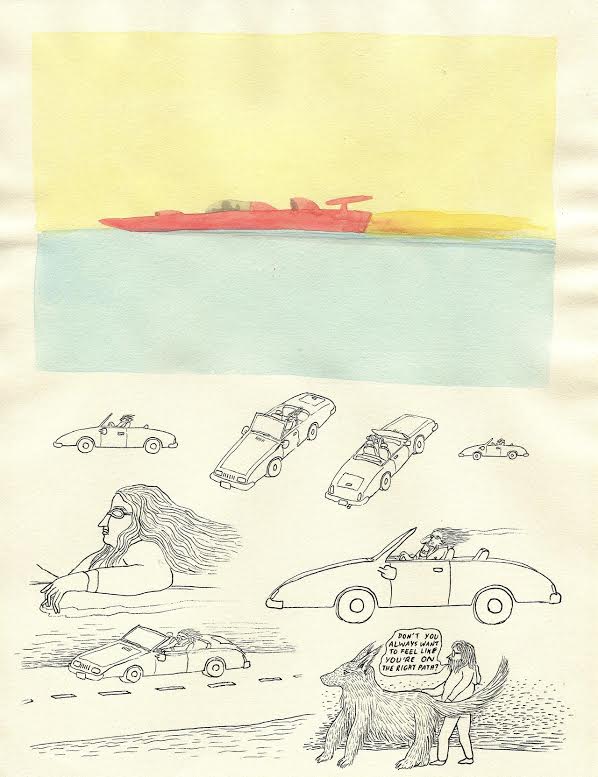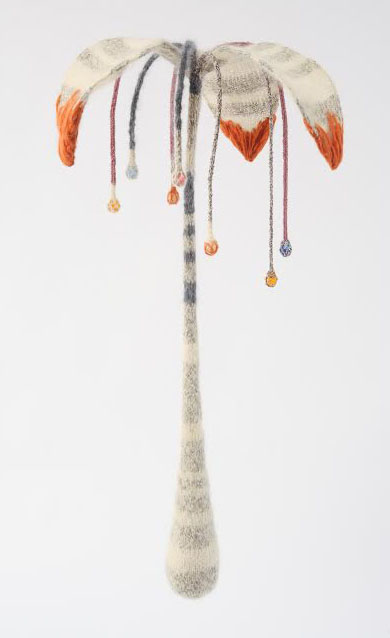PROVIDENCE, R.I. [Brown University] — The David Winton Bell Gallery presents Going Nowhere: Alumni Artists in Providence, featuring work by Peter Glantz ’98, Kevin Hooyman ’98, Xander Marro ’98, Jenny Nichols ’01, David Udris ’90, and Tatyana Yanishevsky ’05. The exhibition will be on display from June 7 through July 7, 2014. An opening reception, including an experimental performance by Glantz, will take place on Friday, June 6, from 5:30 to 7:30 p.m. The performance begins at 7 p.m. Both events will take place in the lobby of List Art Center, 64 College St.
All events are free and open to the public.

Watercolor and ink on paper, 8.5 by 11 inches
In Kevin Hooyman’s simple yet introspective drawings, autobiographical vignettes rendered in ink are juxtaposed with painted scenes of surreal creatures, landscapes, and people. Image and text gesture toward each other but do not resolve into singular narratives.
Similarly, Tatyana Yanishevsky’s whimsical knit sculptures resist categorization. These hanging objects hover between the figuration of anatomically correct flora and abstract biomorphic forms. The natural world is also source material for David Udris, whose abstractions begin from photographs of ice crystallizing on glass. From these images he isolates and enhances patterns into densely layered topographies of color. Deceptively tactile, these manipulated images reflect the changing nature of photographic practice in the digital age.
Jenny Nichols’ bright silkscreened prints depict impossible landscapes and chimerical animals. Often produced as announcements for underground performances, these works are a testament to a thriving national DIY scene for which Providence has been a driving force. As such, they draw attention to the interdisciplinary and collaborative nature of artistic production in Providence. Like much of the work in this exhibition, Nichols’ posters inhabit multiple identities. At once functional, produced in the service of other cultural projects, they also serve as formative aesthetic objects, which Nichols’ develops further in her fine art prints and small paintings.

Love at First Sight (Umbrella Plant) (2012)
Yarn, resin, 46 by 20 by 20 inches
Photo: Karen Philippi
A theater and film director who works both underground and in the public eye, Peter Glantz develops experimental performances. For this exhibition he has created a guided tour of his peers’ work. Poignant and delightful, Glantz’s performances take place in whimsical, slightly unfamiliar realities that nonetheless find meaningful connections with audience members.
Providence has played a critical role in fostering an embrace of the liminal for the artists in Going Nowhere. On the margins of New York, the capital of the art world, it is precisely Providence’s peripheral status that, in the words of Glantz, enables artists to “work inexpensively and experiment outside of the typical demands of high capital.” The city’s abundance of abandoned and affordable live/work spaces has encouraged the emergence of collectives such as the feminist Dirt Palace, which Marro co-founded in 2000 in an abandoned library in Olneyville, and multidisciplinary spaces such as Building 16, where Yanishevsky lived until the building’s inhabitants were evicted in 2013. As Glantz notes, the city attracts “people who are focused more on creating a culture and community through art and performance than their own individual careers.” The work produced for Going Nowhere demonstrates the generative potential of this communal artistic environment.
The David Winton Bell Gallery is located on the first floor of List Art Center, 64 College St. The gallery is open from 11 a.m. to 4 p.m. Monday through Friday and on Saturday and Sunday from 1 to 4 p.m. For more information, call 401-863-2932 or visit www.brown.edu/bellgallery.
